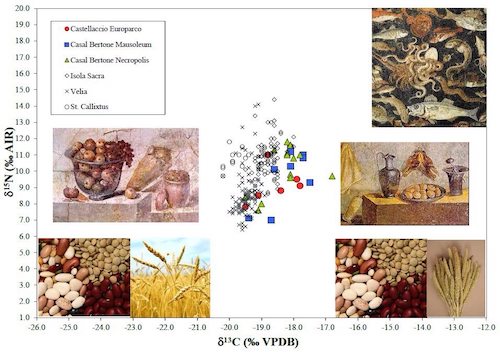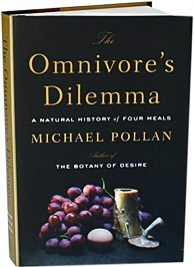I would like to use this post to highlight two authors that I have recently had the pleasure to read in the past few weeks, Kristina Killgrove and Michael Pollan. The graphic shown above comes from Kristina Killgrove, a research associate at University of North Carolina in ecoarcheology. She has a delightfully quirky blog called “Powered by Osteons” (basically about greco-roman skeletons and the TV show “Bones”). In her article on the ancient Roman diet, she points out that diets vary but wheat and olive oil were preferred, more expensive ingredients (no tomatoes or corn) and the average joe probably ate a lot of rye, millet, lentils, turnips and chickpeas due to the fact that they were easier to store and were probably cheap.
“In order to find out what kinds of plain food the ancient Italians were eating, bioarchaeologists are starting to perform carbon and nitrogen isotope analyses of skeletons. Biochemical analysis isn’t perfect, as it only yields a very macro-view of the diet. That is, the carbon isotope ratio can provide information about the kinds of plants and grains consumed, and the nitrogen isotope ratio can provide information on the relative amount of legumes and fish consumed. But depending on the rate of bone turnover, which can be different in different people because of age or disease status, the C and N isotopes (carbon and nitrogen) represent an average of the last perhaps 5-10 years of a person’s diet. With that in mind, the graph shown above demonstrates what the skeletons are telling us about what people were eating in the Roman suburbs and down along the coast during the Empire.
The carbon axis (the bottom axis) shows that the people living in the Roman suburbs and along the coast were eating mostly wheat and barley (C3 foods, which have lower carbon isotope values) rather than millet (C4 food, which has a much higher carbon isotope value, starting around -13.0, way to the right). But their carbon values are higher than a purely C3-based diet, so those could be affected by marine resources and/or consumption of animals that were foddered on millet. The nitrogen axis (the vertical axis) shows that most people were eating a terrestrial, fairly omnivorous diet, with the coastal population of Velia eating a surprisingly little amount of fish. The pure vegetarians would be at the low end of the vertical axis, and the pure fish eaters would be at the high end (along with breastfeeding infants)”.
She went further and devised a recipe for lentil and millet “tabbouleh”, paired with dried apricots, olives and cheese which I tried and found very tasty. I also remind you of Genovese Farinata, made with chickpea flour on the eat.webtoseo.com website. I encourage you to visit her blog and try the recipe.
The American diet contains a significant amount of corn, pushing our carbon values significantly higher and making us quite different from our European, African and Asian cousins. Our reliance on corn, meat fed with corn and corn byproducts, particularly in fast foods and processed foods is the subject of a great book by Michael Pollan.
I and Lisa just finished reading this book on our Kindles and I highly recommend it. I have actually changed my diet after reading the book and you should do the same. Pollan also sees the dominance of corn in the North American diet, he estimates that one quarter of the items in the average American supermarket are corn products. He also recognizes the negative effects this diet is having on our collective health. As he notes:
“If you doubt the ubiquity of corn you can take a chemical test. It turns out that corn has a peculiar carbon structure which can be traced in everything that consumes it. Compare a hair sample from an American and a tortilla-eating Mexican and you’ll discover that the American contains a far larger proportion of corn-type carbon. “We North Americans look like corn chips with legs,” says one of the researchers who conducts such tests.
Pollan describes a Karmic cycle in which the poor health of the feedlotted cows is visited on their consumers. Because they are not allowed to eat grass, their meat is higher in dangerous fats and lower in good ones than that of cows leading a more natural life. There is evidence that all of this dysfunction is leading to an epidemic of psychological depression in America. A study done in 1985 reveals that only 1.3 percent of Americans born in 1910 had suffered a major depressive episode in their lifetime–which is remarkable given the wars, economic crises, and change they experienced–but that 5.3 percent of those born after 1960 had experienced one. “Each succeeding cohort in each area had a higher rate of depression than cohorts before it. There were huge differences…suggesting a roughly ten-fold increase in risk for depression across generations.” Tellingly, the Old Order Amish do not exhibit such a trend, perhaps because their community is more intact”.
Reading this book has given me a new perspective and respect for people who are vegetarians/vegans and the excerpts provided above are only the tip of a nutritional iceberg. I feel better than ever that I grow my own tomatoes and can my own fruit and I plan to make even more changes in my diet. I have to admit I still eat meat and I eat too much, but sometimes change comes slowly. Read this book, it may change your life.



